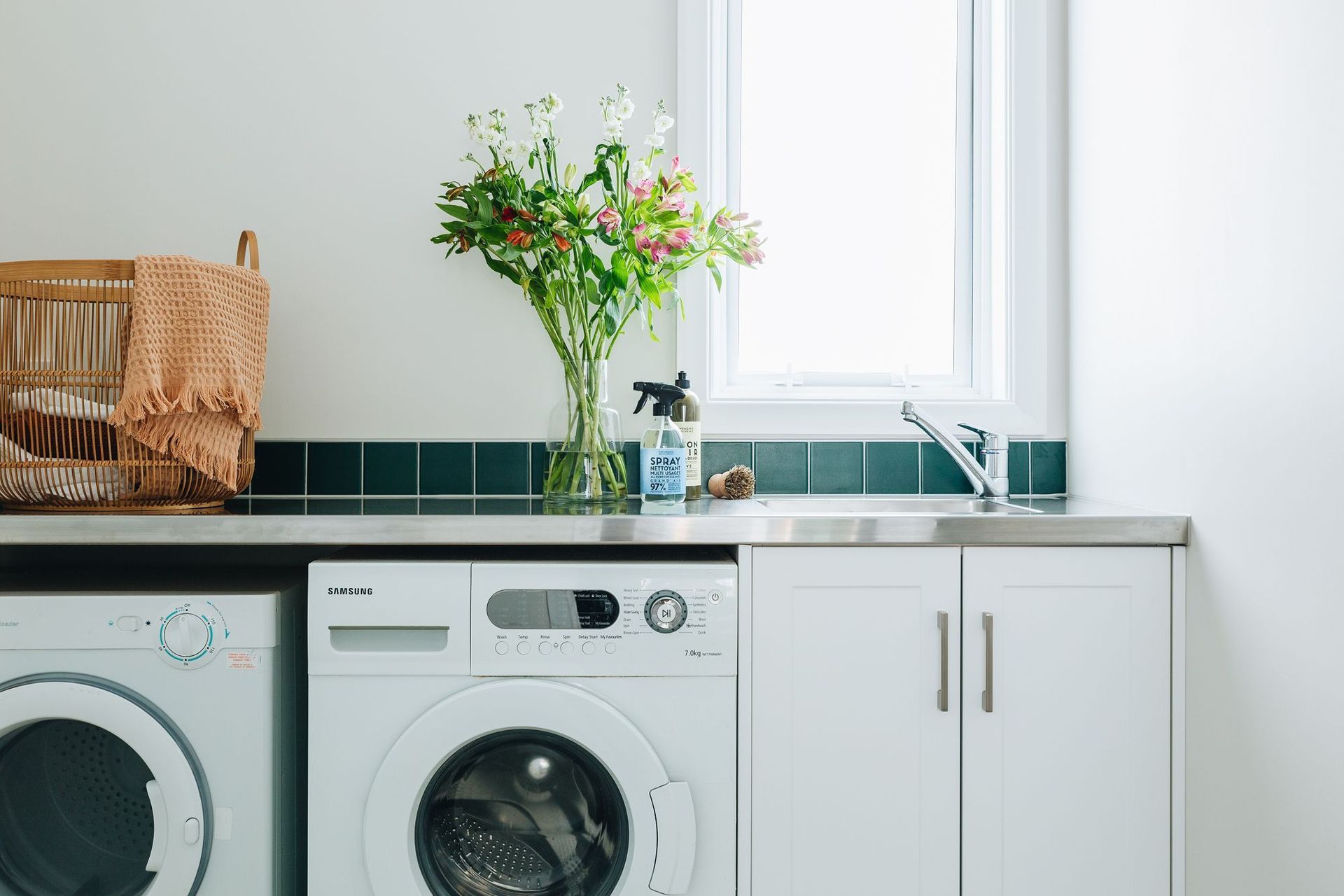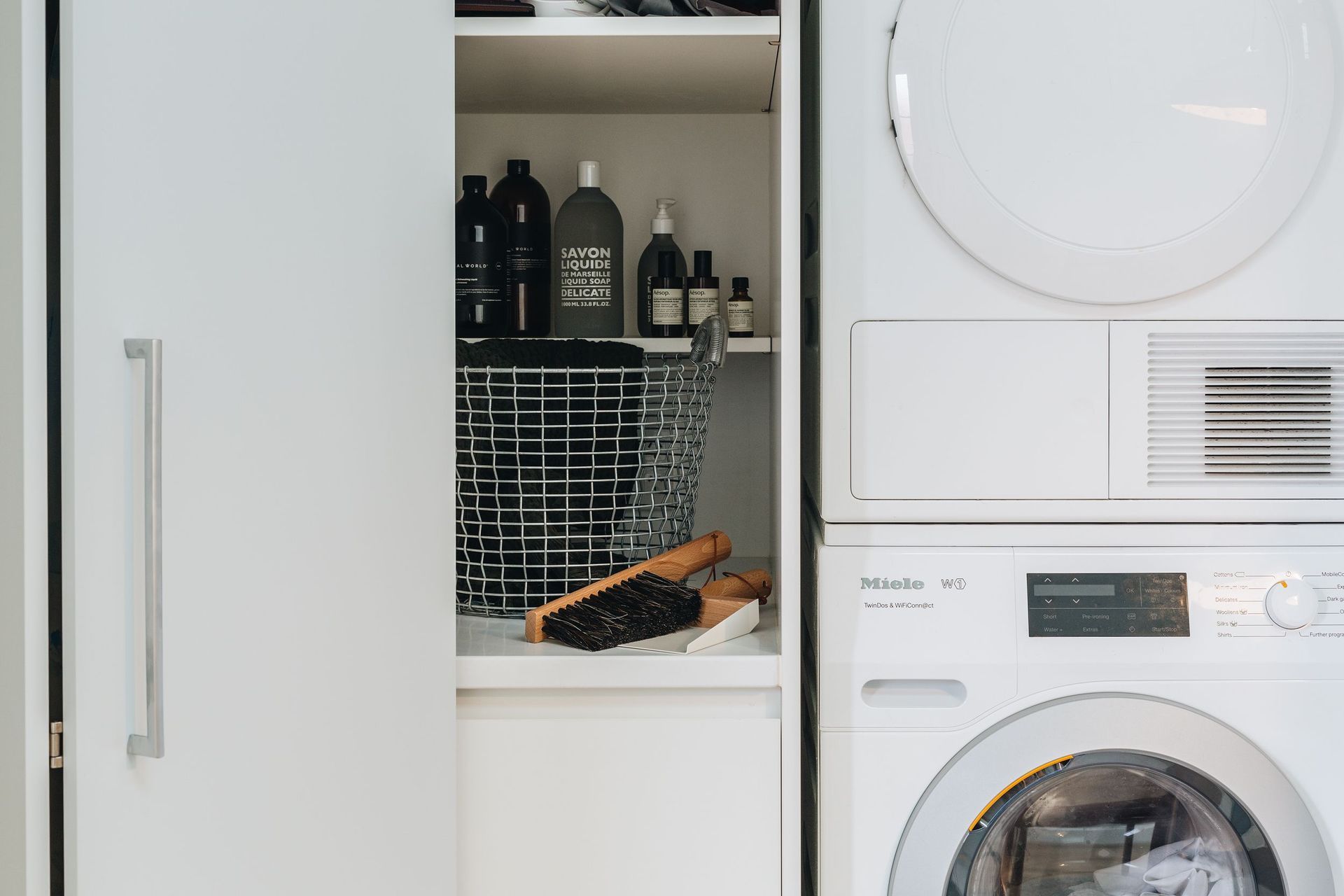Combined Bathroom & Laundry

Incorporating both a bathroom and laundry into one space is a great space saving solution for some homeowners and works well for particular layouts.
The core features of a laundry (washing machine, dryer and tub) can fit in a small space but the The core features of a laundry (washing machine, dryer and tub) can fit in a small space but the activities of using them take up room. If the floorspace of your home is limited, you may not want to allocate a whole room to your laundry nor locate it somewhere like a hallway where laundry baskets and standing at the machine could get in the way when in use, so combining it with another ‘small’ room is an efficient use of available square metres.
Other benefits to combine these rooms are plumbing to one location, similar surface types and wet area considerations and extraction is required for both shower and dryer.
A downside can be that a whilst bathrooms can be for relaxing, the laundry is a utility space, so there is a potential clash in look, feel and noise. These considerations do tend to reduce the appeal of the room-blend, especially if this will function as the only bathroom. Drying clothes and steam from a shower, clean clothes and the toilet, sanctuary and washing machine noise, wanting to throw on a load of washing when someone else is using the bathroom are all things that don’t sit well together for some people.
The minimum amount of space you’d need for a combined laundry and bathroom that includes a shower, vanity, toilet, washer, dry, bench space depends on the proportions of the room and location of door and windows but roughly speaking allow 5.5 M2 for a workable space.
If you were to omit the shower, 4 M2.

To me the key to laying out the room is not so much about how much you can fit in but if you have the space and surfaces to be able to do what you need to do.
If you don’t allow for the functioning and flow of your room and try to put too much in, you could end up with a room that does two things poorly rather than one thing well.
A spacA space-saving technique for any small space is to convert the door to a cavity slider. The swing of a door has a big impact on what you can locate nearby. For example, you don’t want a shower door to clash with your room door or to need to close the main door to use the washing machine and risk getting hit by it if someone else throws it open!
Sufficient horizontal surfaces and storage are key inclusions, as is allowing for person’s movement within the room, bending down, opening doors, reaching for shelves.
Built-in joinery will allow you to maximise the space available by dividing up the room specifically and adding bench space and concealed and open shelving as suits your needs. Allow for other items that might be stored in a laundry as well as the appliances. Drying rack, laundry basket, ironing board, mop or broom? The more you plan for the tidier your final space will be as everything will have a place to live.
The most space-saving way to arrange your washer and dryer:
– If you are stacking your washing machine and dryer, select models that are designed with that in mind and are both front load so you save height. You can then add a slatted shelf above for all-important storage.
– If you have your front loading washing machine and dryer side-by-side you have the benefit of adding a bench above as a work space for sorting and folding plus storage shelves above, perhaps even a mini inside drying rack if you have good air-flow.
The success of a small space packed full of functional elements will be a combination of a design that supports a user freely doing all those activities AND achieves a sense of openness and lack of clutter. Having space for dirty clothes and to open doors and still be able to move around the space will impact on how good the room feels as much as, if not more than, your colour choices.

To minimise visual clutter you can conceal your washer and drier in joinery but only if that doesn’t impede your use of them. Pocket sliders are a more costly piece of hardware than standard or bi-fold hinges and they take slightly more width in a layout but they enable the doors to tuck away, giving free access to your appliances.
Consistent materials and design details for the whole space will make it feel cohesive.
Make sure windows given as much clear space around them as possible (ie if can avoid tall cupboards beside windows there will be better light flow).
If you would like to discover how we can achieve similar results for your residential new build or other interior design project, please complete our online contact form or call Frances Fraser on 027 474 9191, email frances@honourcreative.com.
